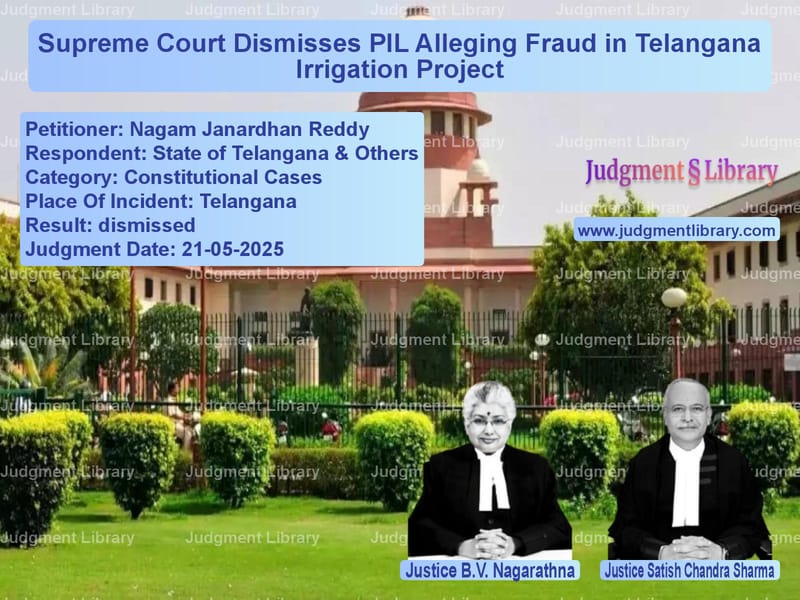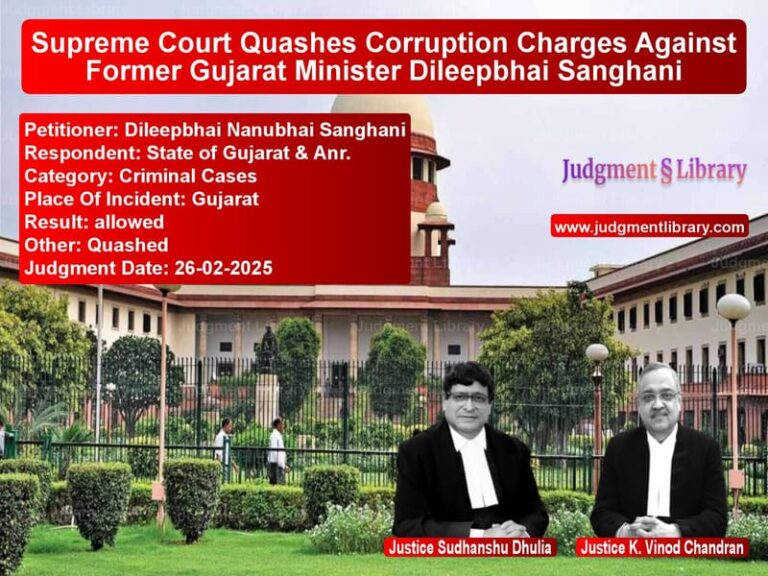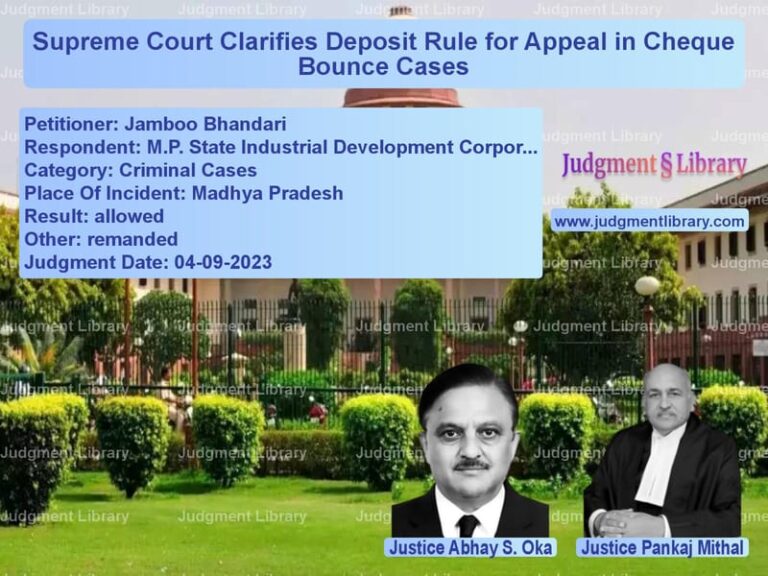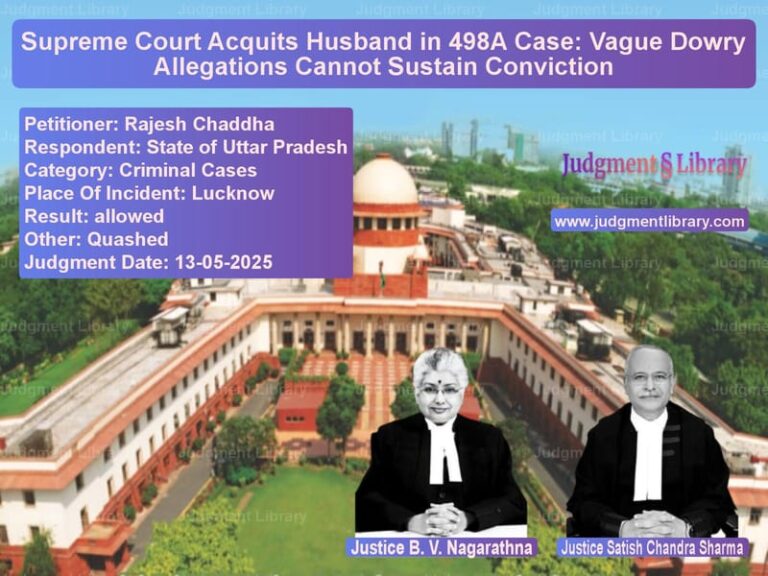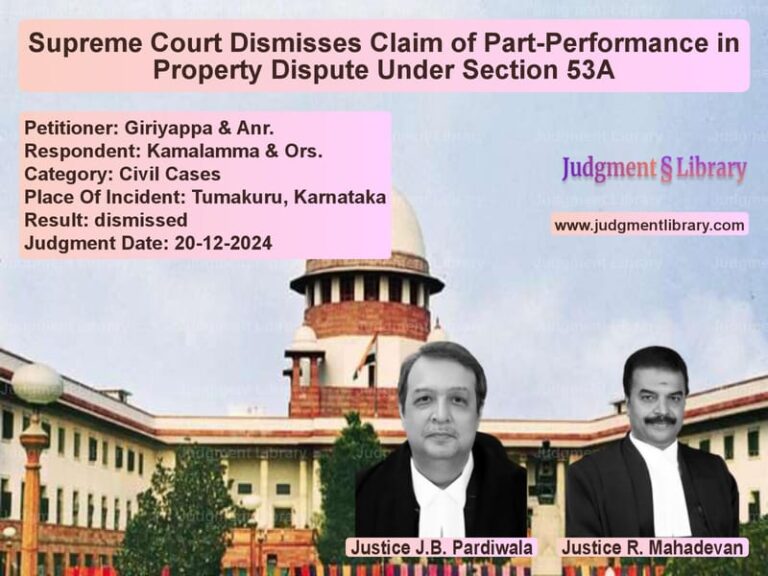Supreme Court Dismisses PIL Alleging Fraud in Telangana Irrigation Project
The corridors of justice witnessed another significant chapter in the ongoing saga of public interest litigation in India as the Supreme Court delivered its verdict in a case concerning alleged financial irregularities in a major irrigation project in Telangana. The case, which had been winding its way through the judicial system for several years, reached its culmination with a ruling that has important implications for how courts handle allegations of fraud in government projects and the scope of Public Interest Litigation.
The legal battle began when Nagam Janardhan Reddy, a seasoned politician with an impressive track record of public service, filed a Public Interest Litigation before the High Court of Judicature at Hyderabad. Reddy, who had been elected as a Member of the Legislative Assembly six times and held ministerial positions for nearly a decade in the erstwhile State of Andhra Pradesh, brought forth serious allegations regarding the Palamuru Ranga Reddy Lift Irrigation Scheme (PRRLIS). His political experience, including his tenure as Deputy Leader of Opposition and Chairman of the Public Accounts Committee from 2009-2011, lent credibility to his concerns about fiscal management in government projects.
At the heart of the controversy was what Reddy described as a fraudulent revision of project estimates. According to his petition, the value of Electro Mechanical (E&M) Equipments for specific packages of the irrigation scheme had been suspiciously increased from Rs. 5960.79 crores as originally estimated by the Engineering Staff College of India to Rs. 8386.86 crores by the Advisor and the Departmental Committee. This revision, he contended, resulted in a staggering loss of Rs. 2426.07 crores to the public exchequer – money that ultimately came from taxpayers’ pockets.
The Legal Battle Begins
Reddy’s journey through the judicial system began with his filing of Writ Petition (PIL) No. 338 of 2017 before the Hyderabad High Court. In his petition, he sought specific reliefs that he believed would address the alleged malfeasance and protect public funds. The prayers in his petition were clear and direct, asking the court to “issue a Writ, Order or Direction, more particularly one in the nature of Writ of Mandamus declaring the action of respondents 1 to 7 in fraudulently revising the value of Electro Mechanical (E&M) Equipments for Palamuru Ranga Reddy Lift Irrigation Scheme for package 1, 5, 8 and 16 from Rs.5960.79 crores as estimated by Engineering Staff College of India to Rs.8386.86 crores by the Advisor and the Departmental Committee thereby causing loss of sum of Rs.2426.07 crores to the public exchequer.”
Beyond this declaration, Reddy also sought consequential actions, including setting aside all decisions related to the disputed packages and, importantly, directing the Central Bureau of Investigation (CBI) to conduct an investigation into the matter and submit a report to the court. This two-pronged approach – seeking both judicial condemnation of the alleged actions and an independent investigative mechanism – represented a comprehensive strategy to address what he perceived as a serious case of financial impropriety.
The High Court, however, after considering the matter, dismissed Reddy’s petition through its order dated December 3, 2018. Unsatisfied with this outcome and believing that justice had not been served, Reddy exercised his constitutional right to approach the Supreme Court through a Special Leave Petition, which was numbered as SLP (Civil) No. 7005 of 2019.
Arguments Before the Supreme Court
When the matter came before the Supreme Court bench comprising Justice B.V. Nagarathna and Justice Satish Chandra Sharma, both sides presented their arguments with vigor. The petitioner was represented by noted advocate Shri Prashant Bhushan, who has built a reputation for taking on public interest causes. The respondents, including the State of Telangana and other project authorities, were represented by senior counsel who mounted a robust defense.
Shri Prashant Bhushan, arguing for the petitioner, contended that the High Court had erred in summarily dismissing the writ petition without proper examination of the facts. He urged that the higher court should have either referred the matter to the CBI for investigation or devised an alternative procedure to uncover the truth. His arguments centered on the premise that a deeper examination would have revealed the fraud allegedly committed in revising the project estimates.
Bhushan’s submissions were precise and pointed: “the High Court ought not to have summarily dismissed the writ petition. Instead, it ought to have gone into the records and considered either referring the matter for investigation to the CBI, or alternatively, devised the procedure by which the truth could have been unraveled, in which event, the fraud in the estimates made as aforesaid would have emerged and consequent actions could have been taken.” He further emphasized that “the High Court has considered the contentions of the petitioner summarily without going into the depth of the matter and has simply dismissed the writ petition.”
To bolster his case, Bhushan drew the Court’s attention to relevant documents, papers, and records which he claimed would “clearly indicate that there is a fraud committed in revising the estimates causing a grave loss to the State exchequer.” He also referenced an earlier order dated December 18, 2024, passed by the Supreme Court in the same SLP, suggesting that the matter deserved a detailed hearing.
The respondents, however, presented a markedly different perspective. The senior counsel representing respondent no. 13, the Project Proponent, argued that the High Court had been correct in dismissing Reddy’s petition, not only for the reasons stated in the impugned order but also because of serious questions about the very maintainability of the writ petition.
The respondents presented a compelling narrative of litigation history, pointing out that this was not the first time Reddy had approached the courts regarding this project. Their counsel drew attention to a chart showing that “earlier PIL Nos.28/2016, 179/2016 and 338/2017 were filed by the very same petitioner, which were disposed of taking into consideration the very same contentions raised by the petitioner at various stages of the very same project.”
This litigation history was crucial to the respondents’ argument that the petition was filed “long after the commencement of the project and portion of it having been completed at a belated stage.” They contended that despite this delay, the High Court had nevertheless considered and answered Reddy’s contentions, making further judicial intervention unnecessary.
The respondents also raised preliminary objections regarding the maintainability of the Special Leave Petition itself, pointing to an earlier order dated August 25, 2022, where the Supreme Court had recorded that the writ petition filed by Reddy before the High Court was “firstly barred by the principle of constructive res judicata and secondly, there was suppression of material facts in the synopsis filed in the present petition.” Based on these grounds, the respondents had argued that the SLP should be heard on preliminary objections before considering the merits.
Perhaps the most significant point in the respondents’ favor came from an unexpected quarter – the Central Vigilance Commission. The respondents informed the Court that the CVC had already examined complaints regarding the same project and had concluded that they were unsubstantiated. Specifically, they drew attention to “an Office Memorandum issued by the Director, Office of the Central Vigilance Commission dated 12.09.2017 to the effect that the complaint regarding contract of PRRLIS packages 5 and 8 worth Rs.8153 crores, was a false complaint and was not at all substantiated.”
In response to these contentions, Bhushan for the petitioner maintained that “there has been a grave fraud in the revision of the values of Electro Mechanical (E&M) Equipments in respect of PRRLIS for packages 1, 5, 8 and 16” and that this was “a fit case where the High Court ought to have exercised its jurisdiction and at least considered the second prayer made by the petitioner herein by referring the matter to the CBI for the purpose of conducting an investigation and submitting a report as the State exchequer has been put to jeopardy on account of fraudulent revision in the estimate of the project.”
The Supreme Court’s Analysis
After considering the submissions from both sides, the Supreme Court bench delivered a carefully reasoned order that addressed the core issues raised in the petition. The Court began by noting that it was primarily examining whether the High Court was justified in dismissing the writ petition and whether it should have exercised its discretion to grant the prayers sought by Reddy.
The Court’s analysis focused separately on the two main prayers in the petition. Regarding the first prayer for a declaration that the actions of respondents 1 to 7 were fraudulent in revising the project estimates, the Court made a significant observation about the limitations of writ jurisdiction. The justices stated: “We find that those are aspects which would call for determination of facts or in other words, a factual adjudication which cannot be done in a writ petition filed under Article 226 of the Constitution of India.”
This statement highlights an important principle in Indian jurisprudence – that writ petitions under Article 226 are generally not suitable for complex factual determinations that require evidence, cross-examination, and detailed examination of documents. Such factual inquiries are typically the domain of civil suits or other appropriate legal proceedings.
Regarding the second prayer for referring the matter to the CBI, the Court noted that the High Court had already considered this request and had declined to exercise its discretion. The Supreme Court affirmed this approach, stating: “We find that the High Court was justified in not exercising its discretion and jurisdiction to refer the matter to the CBI. We do not think that in this Special Leave Petition, we can sit in judgment over the non-exercise of discretion in favour of the petitioner herein and consequently granting the prayer of the petitioner for referring the matter to the CBI for the conduct of an investigation.”
This part of the ruling underscores the Supreme Court’s reluctance to interfere with the discretionary decisions of High Courts unless there is a clear error of law or principle. The Court essentially held that the choice of whether to refer a matter to investigative agencies like the CBI rests within the sound discretion of the High Court, and the Supreme Court would not readily substitute its own judgment for that of the High Court in such matters.
Broader Context and Final Observations
Before concluding the matter, the Supreme Court made several important observations that provided context to its decision. The justices noted that “the petitioner has been pursuing the matter right from the time of issuance of the tender to the project proponent and BHEL.” They recorded that while Writ Petition (PIL) No. 81/2016 was still pending consideration, other petitions had been concluded without further challenge before the Supreme Court, with only a review petition filed regarding PIL No. 28/2016.
Most significantly, the Court placed considerable weight on the findings of the Central Vigilance Commission, noting that “the Central Vigilance Commission by its order dated 12.09.2017, on examination of the complaint made by the very petitioner herein, has stated that it was unsubstantiated and had decided to put the matter to rest.”
This reference to the CVC’s findings is particularly important as it shows the Court’s willingness to rely on the conclusions of specialized investigative bodies. The CVC, as India’s premier vigilance institution, carries significant credibility in matters of alleged corruption and financial irregularities. Its clean chit to the project undoubtedly influenced the Court’s assessment of the petitioner’s allegations.
In its concluding remarks, the Court stated simply: “In the circumstances, we are not inclined to consider this Special Leave Petition any further. Hence, the same is dismissed.” With these words, the legal battle that had spanned nearly a decade came to an end.
Implications and Significance
The Supreme Court’s decision in this case has several important implications for public interest litigation in India. First, it reaffirms the principle that writ petitions are not the appropriate forum for complex factual determinations. Citizens and activists seeking to challenge government actions on factual grounds may need to explore alternative legal remedies such as civil suits or other statutory mechanisms.
Second, the judgment highlights the significance of timing in public interest litigation. The Court took note of the fact that the petitioner had approached the court at a “belated stage” when the project was already underway and partially completed. This suggests that courts may be less inclined to entertain challenges to ongoing projects, particularly when there have been previous rounds of litigation on similar issues.
Third, the case demonstrates the importance of preliminary objections in litigation. The respondents’ successful reliance on principles like constructive res judicata and suppression of material facts shows that procedural defenses can be decisive, even in matters of significant public interest.
Fourth, the Court’s deference to the findings of the Central Vigilance Commission indicates that specialized agencies’ assessments carry weight in judicial proceedings. This may encourage litigants to first approach relevant regulatory or vigilance bodies before coming to court with allegations of financial irregularities.
Finally, the judgment serves as a reminder that public interest litigation, while an important tool for accountability, must be pursued with diligence and in a timely manner. The courts appear to be taking a more cautious approach to PILs, particularly when they involve repeated challenges to the same project or when they are filed after significant delays.
As India continues to balance development needs with accountability mechanisms, judgments like this one will shape how allegations of financial irregularities in infrastructure projects are handled by the judiciary. While the Supreme Court’s decision may disappoint those who believed that serious financial wrongdoing had occurred, it also reaffirms important principles about the scope and limits of judicial intervention in matters of project implementation and governance.
Petitioner Name: Nagam Janardhan Reddy.Respondent Name: State of Telangana & Others.Judgment By: Justice B.V. Nagarathna, Justice Satish Chandra Sharma.Place Of Incident: Telangana.Judgment Date: 21-05-2025.Result: dismissed.
Don’t miss out on the full details! Download the complete judgment in PDF format below and gain valuable insights instantly!
Download Judgment: nagam-janardhan-redd-vs-state-of-telangana-&-supreme-court-of-india-judgment-dated-21-05-2025.pdf
Directly Download Judgment: Directly download this Judgment
See all petitions in Public Interest Litigation
See all petitions in Fundamental Rights
See all petitions in Constitution Interpretation
See all petitions in Judgment by B.V. Nagarathna
See all petitions in Judgment by Satish Chandra Sharma
See all petitions in dismissed
See all petitions in supreme court of India judgments May 2025
See all petitions in 2025 judgments
See all posts in Constitutional Cases Category
See all allowed petitions in Constitutional Cases Category
See all Dismissed petitions in Constitutional Cases Category
See all partially allowed petitions in Constitutional Cases Category

